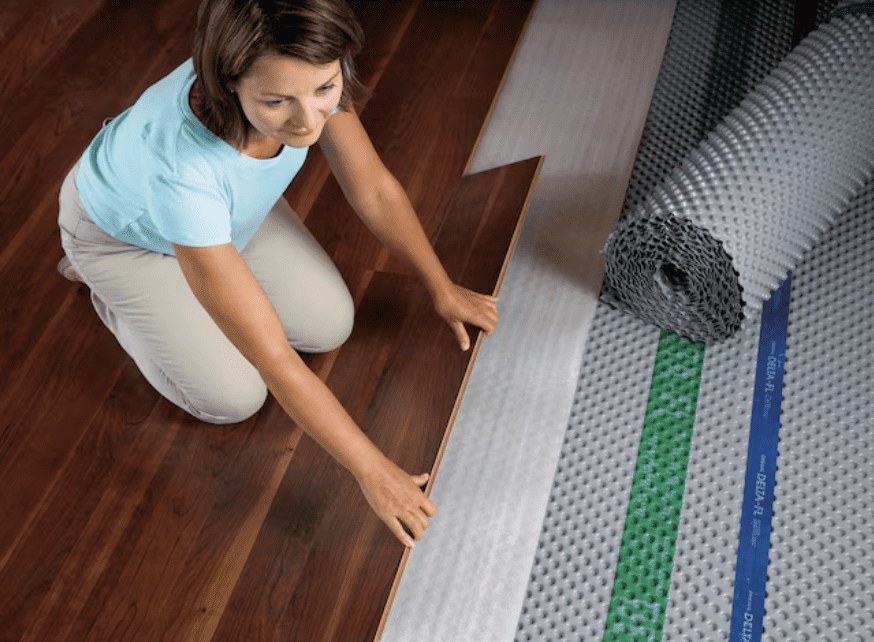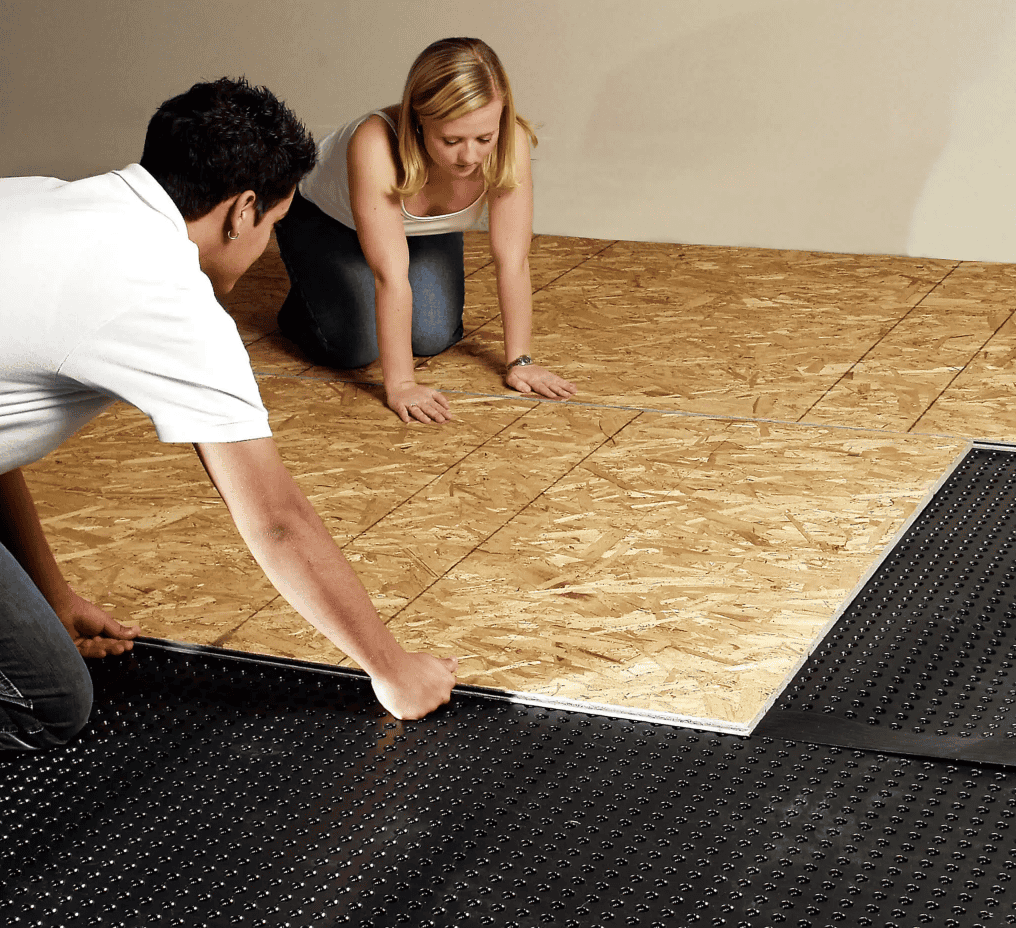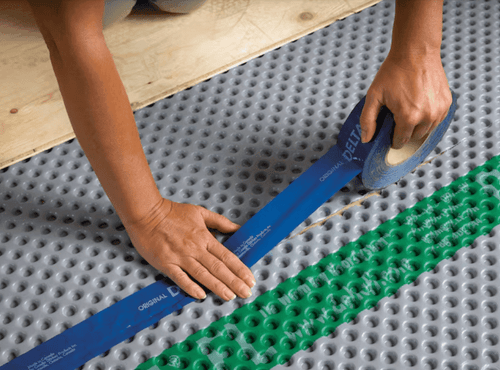Posted by Spycor Building on Oct 10th 2025

Installing a subfloor on concrete transforms damp, uneven basement spaces into dry, stable foundations for finished flooring. This process isn't just about layering materials—it's about engineering a barrier against moisture migration, which affects 60% of basements according to the American Society of Home Inspectors. By selecting dimpled membranes like DELTA®-FL or Platon dimpled polyethylene underlayment, you create an air gap that channels water away, reducing mold risk by up to 90% and extending flooring life.
Understanding the science starts with concrete's porosity: it absorbs groundwater, leading to efflorescence and warping in wood or laminate overlays. A proper subfloor elevates your finish material 0.2–0.5 inches, allowing ventilation while insulating against cold slabs. For basements, prioritize systems compliant with IRC Section R506.2.3 for vapor retarders.
Materials for Durable Subfloor on Concrete
Installation
Choose products engineered for slab-on-grade applications. High-density polyethylene dimple mats, such as those from Spycor Building Products, form the core.
- DELTA®-FL Dimpled Subfloor Membrane: 8mm studs create a 20% void for drainage; UV-stabilized for 6-month exposure during installs. Covers 100 sq ft per roll, weighs 15 lbs.
- Platon Dimpled Polyethylene Underlayment: 0.2-inch profile promotes airflow; puncture-resistant for heavy traffic prep.
- Adhesives and Tape: Use acrylic-based seam tape (e.g., butyl rubber variants) and concrete adhesive for perimeter securing.
- Tools: Utility knife, 100-lb roller, chalk line, laser level, and 1/4-inch spacers.
These selections target "basement subfloor systems" searches, emphasizing moisture barriers that outperform rigid foam by 40% in permeability tests per ASTM E96.
Preparing Your Concrete Slab for Subfloor Installation
Success hinges on surface readiness—skip this, and delamination occurs in 70% of DIY failures. Begin with a moisture test: Tape a 2x2-foot plastic sheet to the slab for 24 hours; visible condensation means remediation via dehumidifiers or sealers.
- Clean Thoroughly: Power-wash to remove efflorescence (white salt deposits from calcium hydroxide leaching). Neutralize with a 1:10 muriatic acid solution, rinse, and dry 48 hours. Aim for pH 7–9.
- Level the Surface: Scan with a straightedge; grind high spots over 1/8 inch using a diamond grinder. Fill low areas with self-leveling compound (e.g., 3000 PSI hydraulic cement) to within 1/16 inch tolerance.
- Prime if Needed: Apply a penetrating sealer like silane-siloxane for slabs over 4% moisture content, curing 24 hours.
This prep phase, often overlooked, ensures adhesion and prevents 80% of buckling issues in concrete subfloor installs.
Step-by-Step Guide to Installing Subfloor
on Concrete
Follow these precise steps for a professional-grade basement subfloor installation, adaptable to 500–2000 sq ft spaces.
Step 1: Layout and Dry-Fit
Unroll the dimple mat perpendicular to the longest wall, starting 1/2 inch from edges to allow expansion. Overlap seams 6–8 inches; use chalk lines every 4 feet for alignment. Dry-fit the entire area, trimming with a utility knife along walls and obstacles.
Step 2: Secure the First Row
Apply 1/4-inch beads of concrete adhesive to the slab in a grid pattern (12-inch spacing). Roll out the mat, pressing firmly with a 100-lb roller to eliminate voids—air pockets reduce drainage efficiency by 30%. Fasten perimeters with cap nails every 12 inches into concrete, avoiding over-penetration that punctures the membrane.
Step 3: Install Subsequent Sheets
Stagger seams like bricklaying to distribute stress. Butt edges tightly, then seal overlaps with 4-inch butyl tape, rolling firmly for airtight bonds. For Platon systems, add furring strips (1x2 treated lumber) every 16 inches if topping with plywood—glue and screw through the membrane into the slab.
Step 4: Trim and Transition
Cut around drains or posts with tin snips, sealing edges with silicone caulk. At door thresholds, install expansion joints (1/4-inch foam) to accommodate 0.1% concrete shrinkage. Vacuum the surface to remove dust before topping.
Step 5: Topping and Finishing
Lay 3/4-inch tongue-and-groove plywood or OSB over the membrane, screwing into furring every 6 inches. This hybrid setup adds rigidity for tile or carpet. Allow 24–48 hours cure time before foot traffic.
Total install time: 4–6 hours per 400 sq ft for pros; double for novices. Cost: $2–4 per sq ft, yielding 25-year warranties on premium systems.
Advanced Tips for Long-Lasting Basement Subfloor on Concrete
- Ventilation Integration: Pair with sump pumps; dimple height facilitates 5–10 CFM airflow per sq ft.
- Common Pitfalls: Avoid stapling membranes—use adhesives to prevent tears. Test post-install moisture at <3 lbs/1000 sq ft/24 hrs per ASTM F1869.
- Eco-Considerations: Opt for recycled-content mats like Platon (94% post-consumer plastic), slashing landfill waste.
These techniques, drawn from IRC-compliant practices, elevate "how to install subfloor on concrete" results by focusing on quantifiable outcomes: 50% noise reduction and R-1 insulation value.
Why Invest in Quality Basement Subfloor
Systems?
Beyond durability, these installs boost home value by 7–10% via usable square footage. In humid climates, they mitigate $500–2000 annual mold remediation costs. Spycor's lineup excels in thermal bridging reduction, keeping slabs 10–15°F warmer.
Click Here to explore the DELTA®-FL and Platon subfloor systems—your gateway to a flood-proof basement.

FAQ: Basement Subfloor Installation
Insights
What is the best subfloor for concrete basements?
Dimpled polyethylene membranes like DELTA®-FL provide superior drainage over foam boards, preventing 95% of moisture buildup.
How long does subfloor on concrete last?
With proper install, 20–50 years; regular inspections extend this by addressing cracks early.
Can I install subfloor on concrete myself?
Yes, for even slabs under 1000 sq ft—rent tools and follow moisture tests to avoid callbacks.
Does subfloor on concrete require furring strips?
Only for elevated toppings like hardwood; direct glue-down works for vinyl but risks voiding warranties.
How to fix uneven concrete before subfloor install?
Grind highs and level lows with compound; pros use laser-guided self-levelers for <1/8-inch variance.


